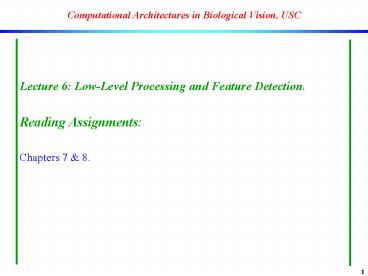Computational Architectures in Biological Vision, USC - PowerPoint PPT Presentation
Title:
Computational Architectures in Biological Vision, USC
Description:
Edge Detection Very important to both biological and computer vision: Easy and cheap (computationally) to compute. Provide strong visual clues to help recognition. – PowerPoint PPT presentation
Number of Views:78
Avg rating:3.0/5.0
Title: Computational Architectures in Biological Vision, USC
1
Computational Architectures in Biological Vision,
USC
- Lecture 6 Low-Level Processing and Feature
Detection. - Reading Assignments
- Chapters 7 8.
2
Low-Level Processing
- Remember Vision as a change in representation.
- At the low-level, such change can be done by
fairly streamlined mathematical transforms - - Fourier transform
- - Wavelet transform
- these transforms yield a simpler but more
organized image of the input. - Additional organization is obtained through
multiscale representations.
3
Biological low-level processing
- Edge detection and wavelet transforms in V1
hypercolumns and Jets. - but
- processing appears highly non-linear, hence
convolution of input by wavelets only
approximates real responses - neuronal responses are influenced by context,
i.e., neuronal activity at one location depends
on activity at possibly distant locations - responses at one level of processing (e.g., V1)
also depend on feedback from higher levels, and
other modulatory effects such as attention,
training, etc.
4
Fourier Transform
5
Problem
- The Fourier transform does not intuitively encode
non-stationary (i.e., time-varying) signals. - One solution is to use the short-term Fourier
transform, and repeat for successive time slices. - Another is to
- use a wavelet transform.
6
Wavelet Transform
- Mother wavelet ? defines shape and size of
window - Convolved with signal (x) after translation (tau)
and scaling (s) - Results stored in array indexed by translation
and scaling
7
Example small-scale wavelet is applied
8
then larger-scale
9
and even larger scale
10
Result is indexed by translation scale
11
Wavelet Transform Basis Decomposition
- We define the inner product between two
functions - then the continuous wavelet transform
- can be thought of as taking the inner product
between signal and all of the different wavelets
(parameterized by translation scale)
12
Orthonormal
- two functions are orthogonal iff
- and a set of functions is orthonormal iff
- with
13
Basis
- If the collection of wavelets forms an
orthonormal basis, then we can compute - and fully reconstruct the signal from those
coefficients (and knowledge of the wavelet
functions) alone - thus the transformation is reversible.
14
Edge Detection
- Very important to both biological and computer
vision - Easy and cheap (computationally) to compute.
- Provide strong visual clues to help recognition.
- Problem sensitive to image noise.
- why? because edge detection is a high-pass
filtering process and noise - typically has high-pass components (e.g.,
speckle noise).
15
Laplacian Edge Detection
- Edges are defined as zero-crossings of the second
derivative (Laplacian if more than
one-dimensional) of the signal. - This is very sensitive to image noise thus
typically we first blur the image to reduce
noise. We then use a Laplacian-of-Gaussian
filter to extract edges.
Smoothed signal
First derivative (gradient)
16
Derivatives in 2D
- Gradient
- for discrete images
- magnitude and direction
17
Laplacian-of-Gaussian
- Laplacian
18
(No Transcript)
19
Another Edge Detection Scheme
- Maxima of the modulus of the Gradient in the
Gradient direction (Canny-Deriche) - use optimal 1st derivative filter to estimate
edges - estimate noise level from RMS of 2nd derivative
of filter responses - determine two thresholds, Thigh and Tlow from the
noise estimate - edges are points which are locally maximum in
gradient direction - a hysteresis process is employed to complete
edges, i.e., - - edge will start when filter response gt Thigh
- - but may continue as long as filter response
gt Tlow
20
(No Transcript)
21
(No Transcript)
22
(No Transcript)
23
(No Transcript)
24
(No Transcript)
25
(No Transcript)
26
(No Transcript)
27
(No Transcript)
28
(No Transcript)
29
(No Transcript)
30
(No Transcript)
31
(No Transcript)
32
(No Transcript)
33
Biological Feature Extraction
- Center-surround vs. Laplacian of Gaussian.
34
Using Pyramids to Compute Biological Features
- Build Gaussian Pyramid
- Take difference between pixels at same image
locations but different scales - Result difference-of-Gaussians receptive fields
35
Illusory Contours
- Some mechanism is responsible for our illusory
perception of contours where there are none
36
Gabor jets
- Similar to a biological hypercolumn collection
of Gabor filters with various orientations and
scales, but all centered at one visual location.
37
Non-Classical Surround
- Sillito et al, Nature, 1995 response of neurons
is modulated by stimuli outside the neurons
receptive field. - Method
- - Map receptive field location and size
- - Check that neuron does not respond to stimuli
outside the mapped RF - - Present stimulus in RF
- - Compare this baseline response to response
obtained when stimuli - are also present outside the RF.
- Result
- - stimuli outside RF similar to the one inside
RF inhibit neuron - - stimuli outside RF very similar to the one
inside RF do not affect (or enhance very
slightly) neuron
38
Non-classical surround inhibition
39
Example
40
Non-Classical Surround Edge Detection
Holt Mel, 2000
41
Long-range Excitation
42
Long-range
- Gilbert et al, 2000.
- Stimulus outside RF
- enhances neurons
- response if placed and
- oriented such
- as to form a contour.
43
Modeling long-range connections
44
Contour completion
45
Grouping and Object Segmentation
- We can do much more than simply extract and
follow contours



























![The Gridbus Toolkit for Service-Oriented [Cluster/Grid] Computing PowerPoint PPT Presentation](https://s3.amazonaws.com/images.powershow.com/P1246211285tuLYR.th0.jpg?_=19691231070)



